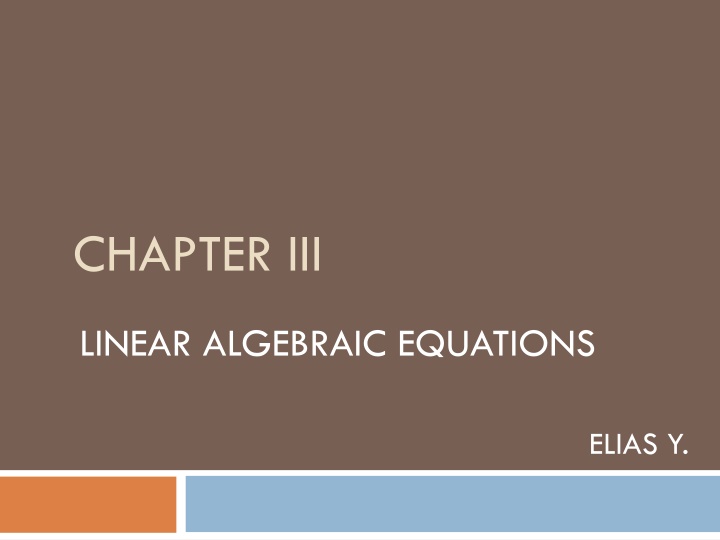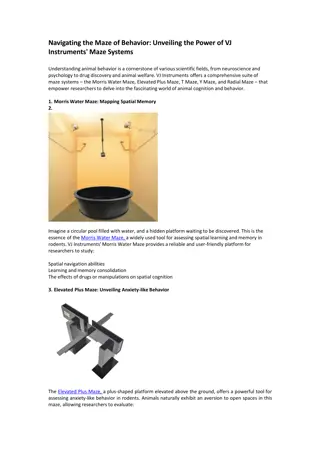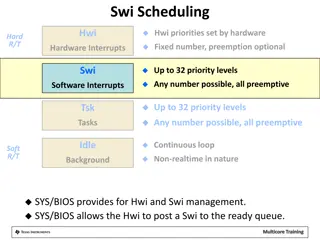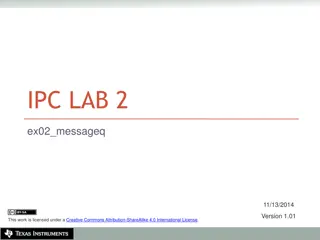
Linear Algebraic Equations: Methods and Techniques for Solving Systems
Dive into the world of linear algebraic equations with this comprehensive guide that explores various methods like graphical representation, Cramer's rule, and elimination techniques. Discover how to solve systems efficiently and learn about the advantages and limitations of each method.
Download Presentation

Please find below an Image/Link to download the presentation.
The content on the website is provided AS IS for your information and personal use only. It may not be sold, licensed, or shared on other websites without obtaining consent from the author. If you encounter any issues during the download, it is possible that the publisher has removed the file from their server.
You are allowed to download the files provided on this website for personal or commercial use, subject to the condition that they are used lawfully. All files are the property of their respective owners.
The content on the website is provided AS IS for your information and personal use only. It may not be sold, licensed, or shared on other websites without obtaining consent from the author.
E N D
Presentation Transcript
CHAPTER III LINEAR ALGEBRAIC EQUATIONS ELIAS Y.
3.1 INTRODUCTION 3.1.1 Objective How to solve systems that have the form of: Where f1,f2,f3, .,fn are linear functions dependent on x1,x2
3.1.2 Contents Graphical Method Cramer s rule Elimination Na ve Gauss Elimination Gauss-Jordan Elimination LU-Decomposition Gauss-Seidel Method
3.2 Graphical Method For a system of linear equations, representing every equation graphically i.e. Lines for 2 variables Planes for 3 variables For n variables, holding m variables constants and studying behavior graphically by varying the rest of the variables(n-m <3)
3.2 Graphical Method Example {-2x+4y=10; 2x-y=11} solution={x=9.0, y=7.0}
3.2 Graphical Method Advantages Help in visualizing the nature of such systems. Singular Infinite solutions Ill-Conditioned
3.2 Graphical Method Disadvantages Useless for systems with rank>=3. 4D and 5D systems aren t what you d think.
3.3 Cramers Rule Applicable for smaller problems [EXAMPLE] [SCILAB DEMONSTRATION]
3.3 Cramers Rule [EXAMPLE] 3x+5y=10 x+2y=5 D=1; D1=-5 ; D2=5 [solution : x=D1/D=-5; y=D2/D=5] [SCILAB]
3.3 Cramers Rule LIMITATIONS If system is larger than rank 3, then evaluation of determinants becomes impractical.
3.4 Elimination methods Na ve Gauss Elimination Gauss-Jordan Elimination Pitfalls of Gauss Elimination Division by Zero Round-off Errors Ill-Conditioned systems Singular systems
3.4.1 Nave Gaussian Elimination Elimination until Upper triangular matrix forms [EXAMPLE][MAXIMA demo]
3.4.1 Nave Gaussian Elimination [SCILAB] (matrices and the inv function) >>>a=[1 2 3;-3 1 5;2 4 -1]; >>>b=[3;-2;-1]; >>>x=inv(a)*b >>>2. -1. 1.
3.4.2 Gauss-Jordan Elimination Perform until the IDENTITY matrix forms on the left side.
3.5 LU Decomposition STEPS: 1.Initial : [A]{X}={B} 2.Decompose [A] into [U] and [L] 3. Construct new sets of systems: [L]{D}={B} .(1) [U]{x}={D} .(2) 4. Solve (1) and get {D} 5. Use {D} from step 4 to solve (2) and get {x}
3.5 LU Decomposition [EXAMPLE] Step 1: Decomposition
3.5 LU Decomposition Step 2: Solve
3.5 LU Decomposition Step 3: Solve
3.5 LU Decomposition Example 2: Alternate Decomposition Method
3.6 The Gauss-Seidel Iterative Method Consider the following system: This system can be transformed into:
3.6 The Gauss-Seidel Iterative Method Steps: 1. Assume initial guesses of x2,x3 .xn=selected values(usually zero) 2. Compute x1 3. Using the result from (2) and initial guesses from step (1),Compute x2,x3,x4 .,xn 4. Using newly computed values of x2,x3,x4 xn compute x1. 5. DO until convergence
3.6 The Gauss-Seidel Iterative Method [Example][FORTRAN Demo]
3.6 The Gauss-Seidel Iterative Method DIAGONAL DOMINANCE An NxN matrix is called diagonally dominant, if the diagonal element in every row is greater in magnitude(Absolute Values) than the sum of the elements in that row excluding the diagonal element. i.e.
3.6 The Gauss-Seidel Iterative Method [Example] The matrix is not diagonally dominant. CHECK: row 1: |-2|<|4|+|-1| row 2: |-1|<|1|+|3| row 3: |1| < |4|+|-2|
3.6 The Gauss-Seidel Iterative Method The matrix can be made diagonally dominant by exchanging rows Can be used to facilitate convergence for iterative methods
3.7 The Conjugate Gradient Method [READING ASSIGNMENT]






